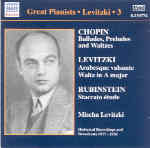Naxos’ third and final volume of Mischa Levitzki’s complete recordings begins with all of the Chopin titles from the pianist’s 1927-33 HMV sessions. A languorous, salonish A major Prelude is sandwiched between full-bodied and businesslike treatments of the C major and F major, both played twice. The A-flat Op. 64 No. 3 Waltz is similarly straightforward, while Levitzki takes special care to articulate the ornaments in the G-flat Op. 70 No. 1 Waltz. Compared to more personalized and dramatic A-flat Ballade recordings from the shellac era (Cortot, Friedman, Moiseiwitsch, for example), Levitzki’s is solid and uneventful. Levitzki’s earthbound, dutiful A-flat Polonaise Op. 53 comes close to matching the fiery, swaggering standards set by Rubinstein and Lhevinne.
The C-sharp minor Scherzo is better, and it’s interesting to hear Levitzki eschew “tradition” by pacing the Trio’s chorale-like theme and subsequent cascading arpeggiated figures in more-or-less strict tempo. He employs more conventional rubato within the F-sharp and C minor Nocturnes–more so, in fact, than his older colleague Josef Hofmann. Rachmaninov’s G minor Prelude alternates between stodgy (the main march theme) and impatient (the central section) in Levitzki’s hands, although the pianist’s supple wristwork and tonal elegance make Rubinstein’s Staccato Etude sound important. And in his last visit to the recording studio (in 1938 for RCA Victor) Levitzky yields slightly perfunctory performances of his own A major Waltz and Arabesque valsante.
Two previously unreleased 1935 airchecks round out this collection. The all-Chopin January 26 broadcast features a more expansive and fluid treatment of the A-flat Ballade, a fanciful, inner-voice-laden C-sharp minor Waltz, and an absolute doofus of an announcer who actually interrupts the A major Prelude midstream. The April 28 broadcast features a sober but well-played Allegro Scherzando from Saint-Saëns’ Second Concerto, and a more inspired rendition of the Arabesque valsante. Patient pianophiles will have no trouble listening past the broadcast material’s scratchy, distorted sonics. As with the previous two volumes, Ward Marston’s clean transfers are fine in and of themselves, but I prefer the additional presence, amplitude, and timbral clarity of Bryan Crimp’s restoration work for APR’s far more expensive edition of Levitzki’s complete HMV output.
































